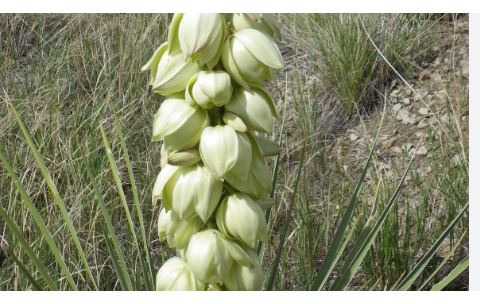
Yucca glauca, commonly known as the Soapweed Yucca, Narrowleaf Yucca, Beargrass or Great Plains Yucca, is part of the Yucca genus within the Asparagaceae family, which was previously classified under the Agavaceae family. This species is distinguished by its tall flower spikes, narrow, sword-like leaves, and the production of soap from its roots. The Latin name “glauca” refers to the bluish or grayish-green color of its leaves.
Yucca glauca is native to the central and western parts of North America, ranging from Alberta and Saskatchewan in Canada, south through the Great Plains of the United States, including states like Montana, South Dakota, Nebraska, Kansas, Oklahoma, and Texas. It’s found in various habitats, from dry prairies and grasslands to sandy or rocky soils, often in areas where it can benefit from full sun exposure.
Historically, Yucca glauca has been significant for both indigenous peoples and later settlers. Native American tribes used every part of the plant: the leaves for weaving baskets, sandals, and mats; the roots for soap and medicine due to their high saponin content; and the flower stalks for food. The crushed roots produce a lather when mixed with water, giving it the name “Soapweed.” European settlers also recognized its utility, using it similarly for soap-making and appreciating its ornamental value. Over time, its drought-resistant nature has made it popular in xeriscaping and as a landscape plant in regions mimicking its native habitat. The plant’s ecological role includes providing habitat and food for the yucca moth, which has a unique symbiotic relationship with yucca species where it pollinates the flowers while laying its eggs inside.
Soapweed Yucca is adapted to USDA Hardiness Zones 4 through 8, reflecting its capability to withstand cold winters and hot, dry summers typical of the Great Plains. Its lifespan can be quite long, often living for several decades, with some plants reaching over 100 years in their natural habitat. This longevity is facilitated by its hardy nature, ability to survive in nutrient-poor soils, and its adaptation to harsh environmental conditions.
Yucca glauca (Yucca Flower): Characteristics
- Growth Habit: Grows as a perennial shrub or small tree, characterized by a rosette of tough, sword-like leaves. It can produce one or more tall, flowering stalks, reaching heights of 3 to 6 feet.
- Leaves: Features long, narrow leaves that are 1 to 2 feet long, with sharp, pointed tips and fine, curling threads along the margins. They are typically a blue-green or gray-green color.
- Flowers: Produces large clusters of bell-shaped, white to creamy flowers on an erect spike. These blooms are fragrant and appear in late spring to early summer, attracting pollinators like the yucca moth.
- Root System: Has a deep taproot system, which allows it to access water in dry environments and contributes to its drought resistance. The root is also rich in saponins, used for soap.
- Adaptability: Highly adaptable to various soil types, from sandy to clay, as long as they are well-drained. It thrives in full sun, with a preference for dry, arid conditions.
- Pollinator Relationship: Has a specialized relationship with the yucca moth, where the moth pollinates the flowers while laying its eggs inside. The larvae feed on some of the seeds without destroying the plant’s reproductive ability.
- Fruit: After flowering, it forms a dry, woody capsule containing numerous flat, black seeds, which are dispersed by the wind or by animals.
- Cultural Uses: Historically used by Native Americans for fiber, soap from the roots, and as food; the flower stalks are particularly noted for their edibility when cooked.
- Drought Tolerance: Extremely drought-resistant, making it ideal for xeriscaping or in landscapes where water conservation is a priority. It can survive with minimal to no supplemental watering once established.
- Ecological Role: Plays a role in stabilizing soil in its native habitats, provides habitat for wildlife, and supports biodiversity through its interaction with the yucca moth and other pollinators.
Yucca glauca (Yucca Flower): Cultivation
Site Selection
- Choose a location with full sun exposure, as Yucca glauca thrives in bright, direct sunlight. It’s well-suited for hot, dry sites that mimic its native prairie or plains habitat.
Soil Preparation
- Prefers well-drained, sandy or rocky soils but can adapt to a range of soil types as long as drainage is good. Avoid heavy, clay-rich soils unless amended for better drainage.
Planting
- Plant in spring or early fall to allow roots to establish before extreme weather. Dig a hole twice as wide as the root ball, ensuring the plant is at the same depth it was in its container. Space plants about 3 to 5 feet apart.
Watering
- Water sparingly after planting to encourage root development. Once established, it’s extremely drought-tolerant, requiring little to no additional watering except in prolonged droughts.
Mulching
- Use a thin layer of gravel or sand as mulch to reflect light and heat back to the plant while allowing for good drainage. Avoid organic mulches that retain moisture.
Fertilization
- Fertilize very lightly or not at all, as Yucca glauca is adapted to nutrient-poor soils. If needed, use a low-nitrogen, slow-release fertilizer in spring.
Pruning and Maintenance
- Prune dead or damaged leaves at the base, but be cautious of the sharp leaf tips. Remove old flower stalks after blooming to maintain appearance and encourage new growth.
Pest and Disease Management
- Generally pest-resistant, but watch for scale insects or spider mites. Ensure good air circulation to prevent fungal issues. Treatment is rarely necessary due to its hardiness.
Propagation
- Propagate by seed, which requires a period of cold stratification, or by offsets (pups) that form around the base of mature plants. Offsets can be separated and replanted in spring or fall.
Winter Care
- In its hardiness zones, no special winter care is needed as it’s quite hardy to cold, especially when established. However, in colder parts of its range, a light mulch of gravel can protect the crown from sudden temperature drops.